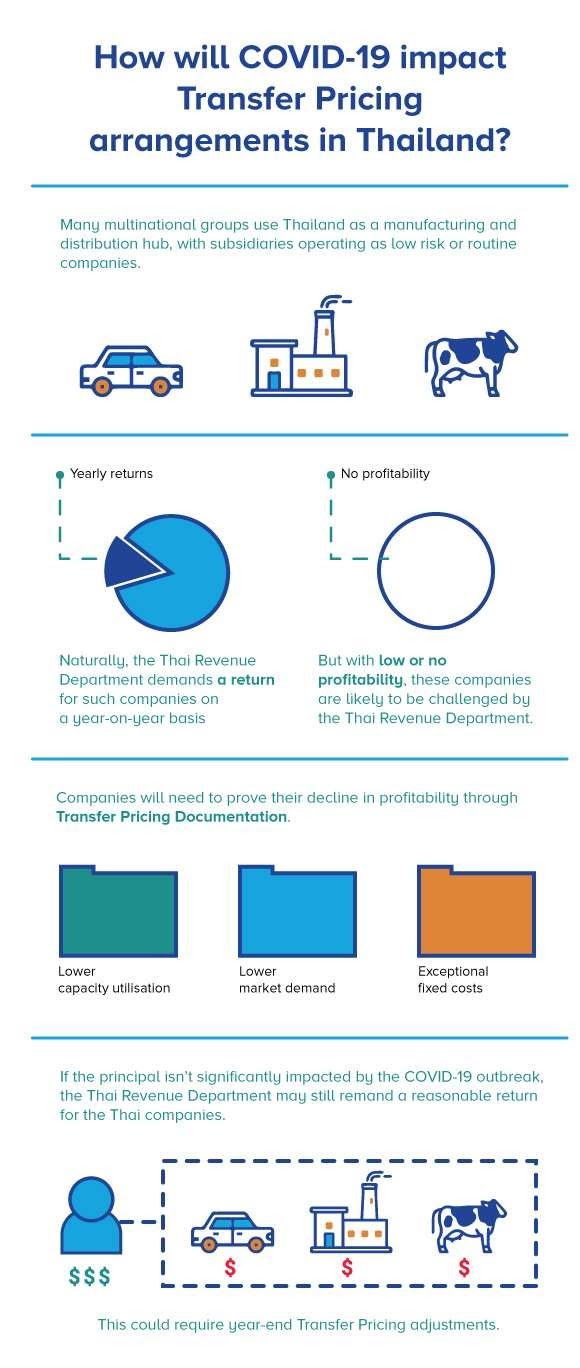The impact of COVID-19 on your Transfer Pricing arrangements
HLB Thailand Tax Team

The COVID-19 pandemic has had an abrupt impact on the world’s economy. Well over a year of economic development has been turned on its head as countries continue to lockdown in a bid to contain the spread of the virus.
The resulting economic fallout has had far-reaching effects on multinational groups (“MNEs”). Many are starting to question how they’ll address low or negative profitability, or changes in Transfer Pricing (“TP”) policies.
While TP may not be the first consideration for MNEs in responding to the pandemic, its importance will become clearer as groups start to restructure their business activities in response to the crisis.
Here are the critical TP areas that need to be dealt with during these unprecedented times.
Transfer Pricing Documentation (“TPD”)
The Transfer Pricing Documentation (“TPD”) requirements are contemporaneous, meaning a taxpayer must use the latest available information and data to establish its Transfer Pricing.
In Thailand, TP law is evolving, and currently lacks the proper guidance for tackling certain issues. For example, if a company with substantial related party transactions should begin reporting low or no profitability due to the economic impact caused by COVID-19, there are no local guidelines for the company to consider in preparing its TPD.
It is therefore essential to focus on the guiding principles provided by the Organization for Economic Cooperation and Development Transfer Pricing Guidelines for Multinational Enterprises and Tax Administrations (“OECD TP Guidelines”), which are mainly followed by the Thai Revenue Department and many other countries.
In this case, MNEs may want to consider the following:
a. Increased focus on industry analysis
Industry analysis requires the assessment of competition and supply and demand trends in the industry. It also assesses the competitiveness of the industry against other developed or emerging markets, and captures the use of intellectual property and technological developments in the industry.
Furthermore, it highlights how credit works in the industry, and the exact impact of external factors. MNEs should intensify their efforts in constructing a detailed industry analysis of the impact COVID-19 has had on the industry, vis-a-vis, the facts and circumstances of taxpayers’ business.
b. Functional, assets and risk (“FAR”) analysis
The FAR analysis should focus on functional and operational disruptions to support current business operations and subsequently the economic analysis.
c. Economic analysis
Given the current circumstances, economic analysis is of significant importance.
Below are a few critical points that should be incorporated into the TPD:
- When it comes to selecting comparable businesses for benchmarking purposes, reassess the quantitative and qualitative filters used. For example, consider accepting loss-making companies (previously rejected on account of reported losses but are functionally comparable) and rejecting companies that are not affected by the current situation.
- Consider using single-year benchmarking results only for comparison purposes. Adopting multiple-year benchmarking results – which is the normal approach – may not yield a proper reflection of the prevailing economic circumstances.
- Accounting and capital adjustments – to enhance comparability, MNEs could consider adjustments for items such as fixed costs, foreign exchange fluctuations, working capital, unutilised capacity, inventory, risk, accounts payable and receivable, and exceptional items.
- Loss/special factor analysis – associated enterprises, just like independent enterprises, can sustain genuine losses, due to unfavourable economic conditions. Moreover, it becomes of utmost importance that such an analysis should be prepared to explain the economic and commercial impact of COVID-19 on the business.
Financing policies and cash flow management
Extraordinary times call for exceptional decision making in order to sustain or secure adequate cash flow. MNEs should consider the impact of its financing policies and cash flow management during this period, including:
- Reassess intra-group financing policies – in the short term, businesses within a group could consider accessing funds from the open market, where beneficial, rather than sources within the group.
Additionally, parent entities could provide support to group companies by extending explicit guarantees to access funds from third parties to address the short-term cash crunch (by providing subsidies or by not charging guarantee fees for such periods).
Existing intra-group funding arrangements could also be realigned or restructured. For example, by:
- Reducing interest rates on existing loans.
- Extending interest/principal payment terms, to assist group companies manage their cash flows.
- Creating a framework for cash pool arrangements (if not followed presently), where group companies having excess funds could contribute for the benefit of other group entities in managing their working capital requirements (reducing time to assess funding options, lowering the cost of funding and minimising paperwork).
- To reduce the burden on the subsidiaries immediately, MNEs could also look to restructure or subsidise the following intercompany arrangements:
- Management and/or technical assistance fees – absorb as a parent of the Group.
- Subsidising the license or the royalty payments.
- Volume discount or reduction in the actual product price to subsidiaries (especially in the case of low-risk distributors)
Alternatively, the arrangements could be reviewed in order to increase intercompany charges in order to manage the group’s cash flows, while still remaining compliant with the Arm’s Length Principle.
Emergency management planning (supply chain)
The COVID-19 pandemic has highlighted to MNEs the importance of business continuity plans to ensure smooth governance and operational effectiveness.
By having a fallback model, a group, to some extent, would be able to manage short-term supply chain disruptions. It would also enable the group to rearrange an alternative subsidiary or a third-party supplier in case a specific company could not meet the demand.
MNEs may need to consider the impact on their TP arrangements by switching to an alternative supplier or adopting other measures that weren’t previously anticipated.
Impact on overall operating model/business restructuring
Changes to business operations in response to the COVID-19 pandemic may lead to a short term or temporary reallocation of functions between the various entities of a group. These may impact their current characterisation, and therefore the overall TP analysis for the group.
If restructuring and reformulating TP policies is required, they should be documented from an economic and commercial standpoint (in the TPD), along with the corresponding tax consequences.
An analysis of ‘options realistically available’ for MNEs to appropriately assess the impact of supply chain modifications to group entities, from a short and long term perspective, will be valuable in this context.
Impact on Master File (“MF”) and Country by Country (“CbC”) report
The master file is a statement relating to the MNE’s global operations and activities, and the pricing policies relevant to Transfer Pricing within the MNE group.
Still confused about the Master File? Read: What’s the difference between a Master file and a Local file?
Country-by-Country (CbC) reports contain valuable information on the global allocation of the income, taxes paid, and the location of economic activity among tax jurisdictions in which an MNE group operates.
These reports are used by tax authorities to make high-level risk assessments of an MNE group to conduct informed TP audits. MNEs should focus on documenting explanations of changes that arise in their reporting compared to prior years.
Advance Pricing Agreements (“APA”)
APAs made with tax authorities are an effective risk management tool to minimise disputes about the TP arrangements adopted. The arm’s length price/range proposed by the taxpayer uses past transactions to forecast future business profits and making so-called ‘critical assumptions’.
These critical assumptions generally don’t consider a change in economic conditions or the FAR of the counterparty involved in the transactions, or fundamental changes in the conditions of a particular industry.
Taxpayers that have agreed an APA with the Thai Revenue Department should review the critical assumptions and assess whether the COVID-19 pandemic might trigger the need for consultation with the tax authorities, to renegotiate the agreed approach, or to revise or cancel the APA.
Taxpayers who wish to apply for an APA in the current environment or are in the process of agreeing an APA, should carefully consider the critical assumptions and the period of the arrangements (normally an APA is made for 3-5 years).
COVID-19 and Transfer Pricing arrangements in Thailand
Thailand is a manufacturing and distribution hub for many MNEs. Usually, their subsidiaries operate in Thailand as low risk or routine businesses, meaning they perform routine functions and assume routine risks as compared to the entire value chain.
The Thai Revenue Department would, therefore, expect a reasonable return on a year-on-year basis for such companies. If they report low or no profitability, such companies are likely to be challenged by the Thai Revenue Department.
As such, these companies should document the reasons for the decline in their profitability in their TPD, showing whether such low or no profitability is caused by lower capacity utilisation, lower market demand, exceptional fixed costs, or other factors.
The tax authorities may also question the financial position of the principal, in case the principal is not significantly impacted due to the COVID-19 outbreak. If not, the Thai Revenue Department may still demand a reasonable return for the Thai companies, as the principal enjoys the entire profits from the transaction.
This is possible by making year-end TP adjustments.
To find out more read our insights on year-end adjustments.
The burden of proof
The sudden changes to the business environment in 2020 have presented serious challenges for businesses and governments alike as they adapt to new and uncertain economic conditions.
It will be vital for MNEs to take a holistic approach as they start to address their TP policies, especially to assist in substantiating losses, the low profitability they may be reporting in the future, or the re-pricing/re-arranging of related party transactions/arrangements.
The burden will be on MNE groups to properly document the impact of COVID-19 on their related party transactions. The preparation and maintenance of Transfer Pricing documentation and related documents (invoices, agreements, emails, etc.) will facilitate reviews by the tax authorities and therefore help resolve any Transfer Pricing issues that may arise.
Although the reporting of lower financial results overall should be expected, MNE groups can expect tax authorities to closely examine changes in financial results reported by group entities with related party transactions.
Without properly prepared Transfer Pricing documentation to show that the transfer prices are at arm’s length, taxpayers are at risk of Transfer Pricing enforcement actions by tax authorities and double taxation arising from those actions.
If you want to learn more about Transfer Pricing, check out our article on Everything you’ve ever wanted to know about Transfer Pricing in Thailand (with examples).
HLB’s Transfer Pricing specialists are here to help.
Thailand’s transfer pricing rules are complex, and can differ greatly from those in neighbouring countries. To stay compliant, book a meeting with Rohit Sharma and his team of local transfer pricing experts at HLB Thailand today.





